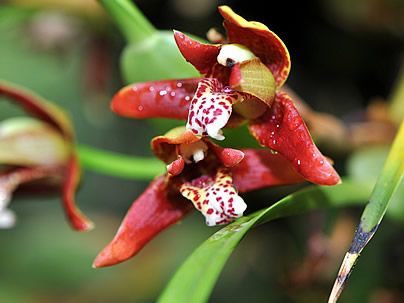The Coconut Orchid (Maxillaria tenuifolia) is an epiphytic orchid native to open forests in regions with altitudes ranging from 1,000 to 1,500 meters (approximately 3,280 to 4,920 feet), found in Mexico, Nicaragua, Guatemala, Honduras, El Salvador, and Costa Rica. As its name suggests, this orchid species is renowned for the intense coconut aroma of its flowers. A favorite among orchid collectors, in addition to its intoxicating fragrance, it features sharply edged flowers with vivid colors and spots that evoke a “wild” appearance.
Its pseudobulbs are globular to oval, slightly flattened, each bearing a single, linear, and long leaf, resembling a blade of grass. The pseudobulbs often remain partially covered by sheaths. The rhizome is dynamic, rising erect and thus positioning the bulbs at different levels. They are arranged in a clump-forming manner, creating dense and disordered tufts.
Flowering occurs in spring, with solitary flowers emerging on short stalks from the base of the pseudobulbs. The flowers of this species are generally orange or red, leaning towards a rust or tile red hue, even to the point of wine-red. The labellum is usually yellow or white, with red spots, presenting an interesting contrast. As is common in the Maxillaria genus, its petals and sepals do not open fully, giving the flower a concave shape.
This orchid is simple to cultivate for those who are already adept at growing, for instance, a Phalaenopsis. It can be positioned under a well-lit window, in any room, avoiding the north-facing side. The foliage alone, even without flowers, creates an interesting ornamental effect. With its long-lasting and fragrant bloom, you will see that it was worth acquiring this species. It is generally planted in wide, shallow pots, but can also be mounted on trees, using sphagnum moss and ties.
The Coconut Orchid should be grown in partial shade or filtered light, usually requiring more light than other epiphytic orchids, but not under full sun all day, especially between 11 a.m. and 4 p.m. Additionally, it prefers a substrate and environment with high humidity, above 50%, and good ventilation. Orchid-specific mixes with a high content of sphagnum moss tend to work well.
Allow the substrate to become almost dry between watering. It enjoys mild to warm temperatures during the day and cool nights. It does not tolerate intense cold, thriving in temperatures between 11° and 30° Celsius (52° to 86° Fahrenheit). Reduce watering in winter. Fertilize in spring and summer with orchid-specific fertilizers. Propagation is by dividing the clumps and, on a large scale, by seeds and meristem culture.


